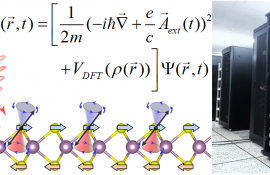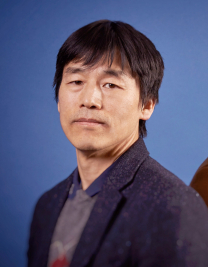- * 프린트는 Chrome에 최적화 되어있습니다. print
Electronic structure theory and computational quantum materials laboratory
전자구조론 및 양자물성 연구실
관련기사 바로가기
Our laboratory’s main theme is the first-principles quantum mechanical calculations of light-matter interactions or full ab initio description of materials’ quantum states under a strong or weak light field. To materialize this vision, we have worked on the electron-correlation part of the time-dependent density functional theory(DFT) and explored the limitation and capability of DFT-based methods.
Since Schrödinger’s and Dirac’s formulation of quantum mechanics at around the late 1920s, diverse branches of theories have developed to deal with quantum mechanics of condensed matters in a way as ab initio as possible. The relativistic or non-relativistic Hamiltonian consists of two-body interactions of every pair of many bodies, which gives rise to enormous complexity in the ab initio treatment. One of the most common approaches is the density functional theory(DFT), in which an effective one-body Hamiltonian is solved self-consistently, and various hierarchical treatments have been introduced to overcome the limitations of such an effective one-body theory. While these methods have been remarkably successful for the ground state or the excited state within the linear response regime, the ab initio description for the non-linear regime of the excited state has remained challenging. On the other hand, the experimental side’s community is rapidly growing toward non-equilibrium or transient phenomena, mainly through the femtosecond pump and probe techniques. Such measurements include perturbations, such as photons or electrons colliding with a condensed matter, and the transient phenomena at the boundary of static phases of multiferroic structures.
Major research field
Computational quantum mechanics of ultrafast dynamics of condensed matter, Light-matter interaction, low-energy excitation of insulators
Desired field of research
Non equilibrium ultrafast dynamics of condensed matters
Research Keywords and Topics
My main focus of interest is to go beyond the current limitation of DFT. The scope of DFT has been limited to the linear response realm of ground state electronic structure. We have been working to expand the boundary of DFT-based methods to transient fast phenomena in non-linear realm by adding explicit electron correlation terms in the framework of real-time evolution of time-dependent DFT. Typical Kohn-Sham scheme of DFT accompanies the phenomenological prescription of the electron system’s correlation, namely the exchange-correlation potential( ). Over the last half century, diverse efforts to improve the DFT and TDDFT, in this regard, have achieved quite fruitful results in the linear-response regime. For example, improvement of long-range behavior in the exchange-correlation kernel can provide quite accurate two-particle excitation spectra. However, no progress has been made toward the dynamics of correlated multiple degrees of freedoms in non-linear regime. For example, when the
Research Publications
MORE· Prediction of ferroelectricity-driven Berry curvature enabling charge-and spin-controllable photocurrent in tin telluride monolayers, Jeongwoo Kim, Kyoung-Whan Kim, Dongbin Shin, Sang-Hoon Lee, Jairo Sinova, Noejung Park, and Hosub Jin, Nature Commun. (2019)
· Unraveling materials Berry curvature and Chern numbers from real-time evolution of Bloch states, Dongbin Shin, Shunsuke A. Sato, Hannes Hubener, Umberto De Giovannini, Jeongwoo Kim, Noejung Park, Angel Rubio, PNAS (2019)
· Phonon-driven spin-Floquet magneto-valleytronics in MoS2 Dongbin Shin, Hannes Hubener, Umberto De Giovannini, Hosub Jin, Angel Rubio, and Noejung Park, Nat. Commun., 9, 638 (2018)
Patents
· “리튬이온 이차전지에서 리튬화합물 전해질 박막의 이온 전도 통로 보호 구조”, 발명자: 박노정, 손삼익, 출원인: 현대자동차, 국립대학법인 울산과학기술대학교 산학협력단, Patent Number: 10-1352791, Date of Patent: Jan. 2, 2014
· “탄소 구조체의 수소화 처리 방법”, 발명자: 한상수, 김형준, 박노정, 출원인: 한국표준과학연구원, Patent Number: 10-1382610, Date of Patent: Apr. 1, 2014
· Facile ferroelectric phase transition driven by Si doping in HfO2, 대한민국, 출원번호 제10-2019-0144294호
국가과학기술표준분류
- NB. 물리학
- NB06. 응집물질물리
- NB0602. 응집물질 계산과학
국가기술지도분류
- 정보-지식-지능화 사회 구현
- 010400. 반도체/나노 신소자 기술
녹색기술분류
- 에너지원기술
- 재생에너지
- 221. 바이오 에너지생산 요소기술 및 시스템 기술
6T분류
- NT 분야
- 나노소재
- 030211. 나노소재기술 (나노분말소재, 광학용 나노소재, 고기능 시너지 소재, 촉매/환경/기능소재에 중점)




